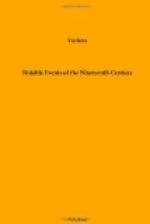How shall we name the asteroids? Piazzi fell back upon pagan mythology for the name of his little world, and called it Ceres, from the Roman goddess of corn. Olbers named the second asteroid Pallas; the third was called Juno—whose rank in the Greek and Roman pantheon might have suggested one of the major planets as her representative in the skies; and the fourth was called Vesta, from the Roman divinity of the hearthstone.
Here then there was a pause. Though the zodiac continued to be swept by many observers, a period of more than thirty-eight years went by before the fifth asteroid was found. The cycle of these discoveries strikingly illustrates the general movement of scientific progress. First there is a new departure; then a lull, and then a resumption of exploration and a finding more fertile than ever. It was on the night of the eighth of December, 1845, that the German astronomer Hencke discovered the fifth asteroid and named it Astraea. After a year and a half, namely, on the night of the first of July, 1847, the same observer discovered the sixth member of the group, and to this was given the name Hebe. On the thirteenth of August in the same year the astronomer Hind found the seventh asteroid, and named it Iris. On the eighteenth of October following he found the eighth, and this was called Flora. Then on the twenty-fifth of April, 1848, came the discovery of Metis, by Graham. Nearly a year later the Italian De Gasparis found the tenth member of the system, that is, Hygeia. De Gasparis soon discovered the eleventh body, which was called Parthenope. This was on the eleventh of May, 1850.
Two other asteroids were found in this year; and two in 1851. In the following year nine were discovered; and so on from year to year down to the present date. Some years have been fruitful in such finds, while others have been comparatively barren. In a number of the years, only a single asteroid has been added to the list; but in others whole groups have been found. Thus in 1861 twelve were discovered; in 1868, twelve; in 1875, seventeen; in 1890, fourteen. Not a single year since 1846 has passed without the addition of at least one known asteroid to the list.
But while the number has thus increased to an aggregate at the close of 1890 of three hundred and one, many of the tiny wanderers have escaped. Some have been rediscovered; and it is possible that some have been twice or even three times found and named. The whole family perhaps numbers not only hundreds, but thousands; and it can hardly be doubted that only the more conspicuous members of the group have ever yet been seen by mortal eye.




